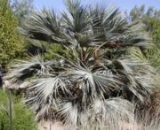
Brahea armata
Encyclopedia
Brahea armata, commonly known as Mexican blue palm or "blue hesper palm", is a palm
is native to Baja California
. It is widely planted as an ornamental.
It grows to a height of 15 meters, with a stout trunk. Its distinctly bluish leaves are 1-2 meters wide, with meter-long petiole
s. The leaves are persistent in nature, forming a shag around the trunk; in cultivation they are typically burned or cut off. The inflorescence
s extend out beyond the crown, reaching 5 meters in length. The flowers themselves are small, appearing in February and March, while the fruits are 18-24 mm in length, brown and with a generally ovoid to globose shape.
This species is the most widespread endemic palm of the northern peninsula; it is locally common in arroyos and canyon bottoms, and has been observed growing in rock crevices at higher elevations. It is sometimes found with Washingtonia filifera
or Washingtonia robusta
B. armata has an attractive appearance, especially when young, and is commonly available at nurseries in the American southwest. It is drought tolerant (although occasional deep irrigation is recommended), can handle both partial shade and full sun, and temperatures down to -10 degrees C. It is found under a variety of names, including "Mexican blue palm", "blue hesper palm", "big blue hesper palm", "blue fan palm", "sweet brahea", and "palma blanca".
The Cocopah people ate the seeds after roasting them.
Arecaceae
Arecaceae or Palmae , are a family of flowering plants, the only family in the monocot order Arecales. There are roughly 202 currently known genera with around 2600 species, most of which are restricted to tropical, subtropical, and warm temperate climates...
is native to Baja California
Baja California
Baja California officially Estado Libre y Soberano de Baja California is one of the 31 states which, with the Federal District, comprise the 32 Federal Entities of Mexico. It is both the northernmost and westernmost state of Mexico. Before becoming a state in 1953, the area was known as the North...
. It is widely planted as an ornamental.
It grows to a height of 15 meters, with a stout trunk. Its distinctly bluish leaves are 1-2 meters wide, with meter-long petiole
Petiole (botany)
In botany, the petiole is the stalk attaching the leaf blade to the stem. The petiole usually has the same internal structure as the stem. Outgrowths appearing on each side of the petiole are called stipules. Leaves lacking a petiole are called sessile, or clasping when they partly surround the...
s. The leaves are persistent in nature, forming a shag around the trunk; in cultivation they are typically burned or cut off. The inflorescence
Inflorescence
An inflorescence is a group or cluster of flowers arranged on a stem that is composed of a main branch or a complicated arrangement of branches. Strictly, it is the part of the shoot of seed plants where flowers are formed and which is accordingly modified...
s extend out beyond the crown, reaching 5 meters in length. The flowers themselves are small, appearing in February and March, while the fruits are 18-24 mm in length, brown and with a generally ovoid to globose shape.
This species is the most widespread endemic palm of the northern peninsula; it is locally common in arroyos and canyon bottoms, and has been observed growing in rock crevices at higher elevations. It is sometimes found with Washingtonia filifera
Washingtonia filifera
Washingtonia filifera , with the common names California Fan Palm , Desert Fan Palm, Cotton palm, and Arizona Fan Palm. It is a palm native to southwestern North America between an elevation range of , at seeps, desert bajadas, and springs where underground water is continuously available...
or Washingtonia robusta
Washingtonia robusta
Washingtonia robusta is a palm tree native to western Sonora and Baja California Sur in northwestern Mexico. It grows to tall, rarely up to . The leaves have a petiole up to long, and a palmate fan of leaflets up to 1 m long. The inflorescence is up to long, with numerous small pale orange-pink...
B. armata has an attractive appearance, especially when young, and is commonly available at nurseries in the American southwest. It is drought tolerant (although occasional deep irrigation is recommended), can handle both partial shade and full sun, and temperatures down to -10 degrees C. It is found under a variety of names, including "Mexican blue palm", "blue hesper palm", "big blue hesper palm", "blue fan palm", "sweet brahea", and "palma blanca".
The Cocopah people ate the seeds after roasting them.

